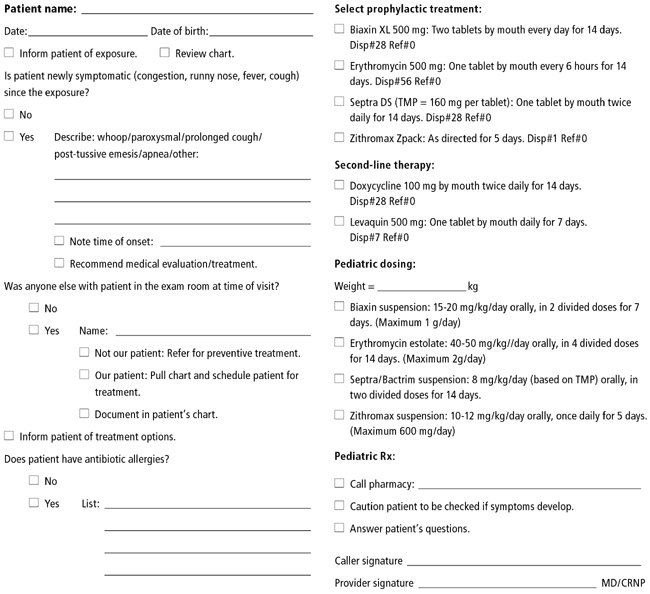
A physician shares the lessons he learned after unknowingly exposing patients and staff to whooping cough.
Fam Pract Manag. 2005;12(7):31-3

Vaccines for measles and polio have effectively reduced those diseases to rarities almost never encountered by today's family physician. In addition, the disease burden of pertussis, like tetanus and diphtheria, has been dramatically reduced in the United States through relatively high immunization rates with efficacious vaccines. Contrary to the perception of many physicians, however, waning pertussis immunity in adults and adolescents means that whooping cough is not a relic of the past.
Our practice was reminded of this recently when I became the index case in a community-wide pertussis outbreak. In the time before I started antibiotics and was diagnosed, I continued to fulfill my duties, as most mildly ill but committed physicians would have done. I saw patients at the office, rounded at the hospital and taught medical students, despite an increasingly intrusive cough. Although I had a polymerase chain reaction (PCR) for pertussis sent off, it wasn't until I found myself coughing one night and heard a single, questionable “whoop” that I began to seriously suspect pertussis. Even then, I didn't fully comprehend the implications of this, nor did my partners. I began to mask before examining children and awaited my PCR results.
The test returned positive, and our medical director contacted the state health department, which recommended that I stop seeing patients until I had been on five full days of an appropriate antibiotic. At that point, I had already taken azithromycin for three days. This meant that I had to stop seeing patients for two full days, including my 8 a.m. patient who was already waiting for me in the exam room. The health department also recommended that our office follow up with and treat prophylactically all the patients and nonpatients I had contacted since my symptoms began. With that advice, we were initially on our own to deal with the situation, though a public health nurse was briefly sent to our office the following week to monitor our progress.
As a primary care physician in a busy five-provider office, I had exposed more than 300 people, all of whom needed to be contacted, screened for pertussis symptoms, and prophylaxed or treated. The prospect was daunting, but it was only after making 10 to 20 phone calls that the gravity of the situation became clear. A “Concise Guide to Dealing With a Pertussis Outbreak in a Primary Care Office” would have been a valuable commodity at that point. Instead, we found lengthy and sometimes conflicting information from the Internet, printed materials and verbal sources that we investigated. Nevertheless, in the end we were highly successful in preventing a potentially large outbreak from starting in our office, although this success came at the price of large amounts of time and energy.
KEY POINTS
The incidence of pertussis in the United States continues to rise as immunity in adults and adolescents wanes.
Family physicians need to think about how they would respond if someone in their practice became the index case in a pertussis outbreak.
Defining treatment options is a critical part of pertussis outbreak management.
The onset
I had begun the catarrhal (i.e., nasal congestion) stage of pertussis on Oct. 11, 2004. I was sure of this date because my wife had noted in her diary that I was “coming down with a bug” that day. This onset date became particularly important because it established the start of my infectious period and determined the number of patients we would need to contact and treat. I initially underestimated the onset of my symptoms by three to four days. Like many health care providers, I wasn't significantly concerned with typical viral symptoms in myself. The diary entry, therefore, became a key part of the epidemiological data.
Because the highest morbidity and mortality associated with Bordetella pertussis is seen in infants less than 6 to 12 months of age, my office was most concerned with contacting this group, along with pregnant patients and patients with small children at home. Before the mid-1940s, when whole-cell diphtheria-tetanus-pertussis (DTP) vaccine was first introduced, the United States averaged more than 160,000 pertussis cases annually and more than 5,000 pertussis-related deaths each year.1 Most of these deaths were in children less than 6 months of age, with bacterial pneumonia being the most common complication.
After routine immunizations began, however, the pertussis rate dropped 99 percent by 1976.1 Nevertheless, between 1980 and 2000 the incidence of pertussis in the United States quadrupled.2 The number of cases reported was 11,647 in 2003 and jumped to 18,957 in 2004.3,4 Our practice had become part of this surge in new cases.
Screening and treatment
We dedicated our office manager and two of our six nurses to focus on the administrative task before us. Conversations with key staff at our hospital about medicolegal concerns convinced us that we needed to contact each patient individually by phone or in person, not by mail as we had originally planned.
On the first day of outbreak control, Oct. 23, we began calling patients and recording our conversations in the chart. Our initial progress was slow, making it apparent that it would take longer than anticipated to contact the patients represented by the charts surrounding us. These charts had been pulled based on lists of patients whom I had seen during the 12 days since the onset.
To facilitate the process of identifying patients who had pertussis symptoms, I created a template that we used to screen the patients we contacted. This form documents the following: symptoms, drug allergies, contraindications to treatment, and prophylactic treatment provided or recommendations to be seen immediately for testing and treatment. Any patient who was symptomatic was seen and evaluated, after being masked upon entering the office. If appropriate symptoms were confirmed at the visit, the patient was tested for pertussis and advised to avoid close contact with others during treatment.
Our medical center's infectious diseases team recommended PCR testing on symptomatic patients. This method provides relatively rapid results and is useful even when patients have already been treated with antibiotics, which is not the case with culture. Nevertheless, culture is still considered the gold standard for diagnosing pertussis because it is 100 percent specific. Sensitivity varies significantly, however, ranging from greater than 50 percent under ideal conditions to less than 20 percent.2 The organism is quite fastidious and must be kept alive after sampling to allow for growth on culture media. Variables that decrease culture sensitivity include delays in direct plating of specimens, use of transport media before direct plating, delays in obtaining the specimen beyond two weeks of illness, sampling patients already treated with antibiotics, or culturing previously vaccinated patients. The result is a potentially high false-negative rate and continued spread of the illness. Culture does, however, have a significant cost advantage. Consequently, other local medical offices elected to use culture rather than PCR testing.
Defining treatment options became a critical part of the pertussis outbreak management. With the help of our Hershey Medical Center phone consultants, we identified first-and second-line antibiotic therapy. Data exists for using erythromycin and the other macrolides, as well as trimethoprim/sulfa-methoxizole. However, for patients allergic or intolerant to these, we were advised to offer doxycycline or levofloxacin as alternatives to no treatment. The recently released ketolide, telithromycin (Ketek), was also thought to be effective based on in vitro studies, but we did not offer it because of limited practical experience with this new drug.
PERTUSSIS SCREENING FORM

Developed by Michael P. Flanagan, MD, FAAFP. Copyright © 2005 American Academy of Family Physicians. Physicians may photocopy or adapt for use in their own practices; all other rights reserved. "How to Manage a Pertussis Outbreak in Your Practice." Flanagan MP. Family Practice Management. July/August 2005:31-34; https://www.aafp.org/fpm/20050700/31howt.html.
A final word
After working steadily for four days, including most of a weekend, we were able to contact more than half of the people I had unknowingly exposed. We also notified other local physicians regarding the outbreak, sharing disease management information when appropriate.
Assistance from our hospital's two infectious disease nurses and our office nursing and medical staff, all of whom worked long hours, allowed us to contact all high-risk patients within 48 hours. Subsequently, we dedicated one office nurse to spend the next week making follow-up phone calls to patients who were not available on the first call and organizing charts as patients were reached and taken off our contact list. Having a close doctor-patient relationship with most of these patients facilitated this process.
In the end, we were able to document that no confirmed pertussis cases arose from direct exposure to me, although more than 100 unrelated, community-acquired cases were diagnosed by local physicians during the weeks that followed.
It was not until two months after my own illness that I was able to identify where I had contracted pertussis. My exposure likely came from a 13-year-old neighbor who was eventually designated a confirmed case based on epidemiological data, and not from a patient I had failed to diagnose. I had driven my neighbor and three other students home from a church activity two weeks before developing symptoms. Spending 45 minutes in the car together, with her coughing frequently in the passenger seat beside me, produced an adequate exposure.
It was an event that went on to become quite a learning experience, not the least of which occurred very recently, when one of my Asian patients shared the Chinese term for pertussis: the one-hundred day cough.